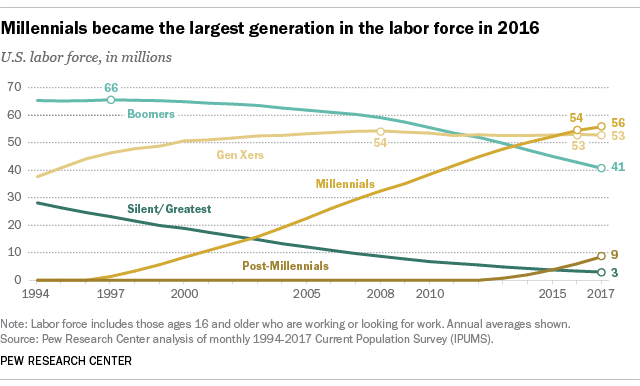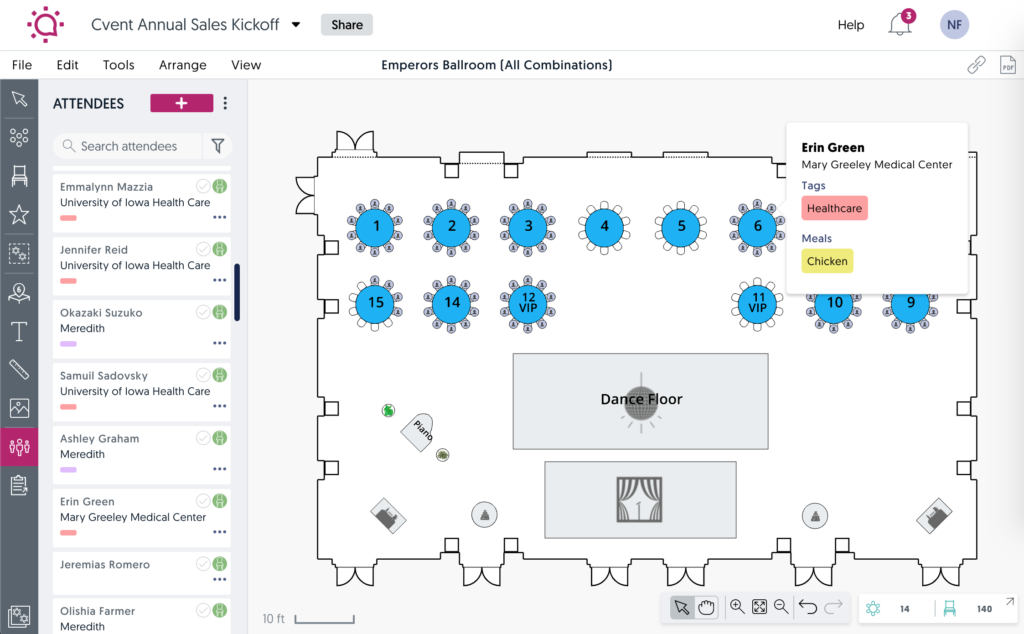
5 Meeting Industry Trends That Are Changing the Face of Events
Meetings don't look how they used to. Today, planners are racing to adapt to trends that make conferences and events more engaging and dynamic than ever before.
But when it comes to trends, where should meeting industry professionals put their focus? While the shifts are plentiful, there are five that stand out from the fold when it comes to modern event design.
Here are five meeting industry trends that are changing the game.
1. Millennials are the decision makers now.
In 2016, millennials became the largest segment in the U.S. labor force, at 35%. Because of that, they're also now the largest pool of potential meeting attendees.

Since the meeting industry is shaped by attendee expectations, successful events have to cater to millennials.
So what do millennials want? Like every generation before them, their desires are shaped by the realities of larger historical events.
Here's how Skift reporter Greg Oates put it: "Think about graduating in the last 10 years and how competitive it is ” jobs aren’t guaranteed, there was a recession, there was everything after 9/11. Events became the professional development pipeline for that generation."
For these reasons, millennials value networking over almost any other aspect of events. As a demographic, they also:
- Value experiences over material goods
- Want to share those experiences usually via social media
- Have higher technological literacy
- Are 62% more likely to travel than their generation X counterparts
- As the average screen time per day increases, millennials place more value on face-to-face meetings.
All of the above is driving the generation's expectations for meetings and events, ultimately redefining the meeting industry entirely.
2. Attendees want more control over the meeting agenda.
Gone are the days of static schedules, where speaker after speaker shuffle on stage while attendees remain seated.
Today, personalization is key. Attendees want fluid agendas with many options that appeal to different interests and preferences. In many cases, this means crowdsourcing the agenda ” sometimes eve in real time ” to present a personalized event agenda.
Letting attendees choose their path links them to the content at hand. When they can choose topics that excite them, there's more energy and increased engagement in the room.
However, this shouldn't just apply to content. Food, activities, and even breakout spaces should give attendees an element of choice.

Experient designs unique meeting experiences with event personas.
Over the 45+ years that Experient has served the industry, it's defined 20+ event personas. These personas group attendees into buckets based on their preferences, motivations, and actions. These personas make industry planners' lives easier ” even for Experient.
For a recent meeting, the Experient team created "journey maps." Wiht this tool, the team outlined completely different experiences for attendees based on their personas. They present different agendas to each persona on each day of the event. This way, they could personalize every element of the experience ” from the food to offsite activities.
Take the Be-Wellster and the Post-Master as examples. For Be-Wellsters (attendees who prioritize health and wellbeing), the agenda included meditation, morning runs, nutritious meals, and even a yoga flow. For the Post-Masters (aka Instagram-savvy social media mavens), the team rounded up recommendations of local entertainment and provided picturesque backdrops that screamed photo-op.
[Tweet "In 2016, millennials became the largest segment in the U.S. labor force at 35%."]
3. Meetings should be "purposeful" experiences.
The new generation of meeting attendees don't want to be ushered into a ballroom to sit and listen. Today, the meeting industry trend includes fresh event concepts and meetings with meaning, innovation, and insight.
Just as importantly, attendees are looking elements inclusive of behavioral science, wellbeing, and a connection to the world at large. In short, today's attendees want meetings to have a purpose.
These "purposeful meetings" are a large part of why 80% of event planners say that their jobs involve more experience creation than they did 2 to 5 years ago.
As Janet Sperstad's white-paper Purposeful Meetings: How to Plan With Deeper Meaning, Innovation, & Insight shows, the concept of "purposeful meetings" became the theme of IMEX America 2017. And it continues to be the focus of the meetings industry.

C2 pushes the envelope for event experiences.
Trapeze chairs, a speakeasy, smoothie shots at the revolving entrance, Cirque du Soleil performances... The laundry list of creative attractions at Montreal's C2 conference sounds more like a festival than a networking event. But make no mistake ” the networking is there: over 3,000 face-to-face meetings were scheduled at C2 2017 alone.
Insta-worthy stunts aside, C2's innovative approach brought professionals together in an event that offered engagement and interaction around every corner. In fact, attendees had 11 different ways to spend every single hour of the event.
Fittingly, the theme of the event was "transformative collisions." Sometimes, that meant a face-to-face meeting in a private cabin, and at other times, it resulted in an unexpected encounter with a ninja. C2 more than lived up to the theme, providing exceptional networking spaces and technology along with a heaping helping of the unexpected.
(Oh, and in case you're wondering, the speakeasy was hidden in the flower shop freezer.)
4. Technology helps planners pull off more than ever before.
As you can tell, planners are expected to design more complex, innovative experiences than ever before. Meanwhile, according to the AMEX Global Meetings Forecast, the numbers of meetings annually has only grown 5.4% since 2009, but the total number of attendees at these meetings has grown by 22.7%.
Put simply, meetings aren't just more complex. They're also just plain bigger. So what's a planner to do?
Event technology is answering the call, evolving as fast as the industry itself. In fact, studies show using event technology can:
- Decrease costs by up to 30%
- Increase planners' productivity by 27%
- Increase attendance by 20%
These technologies help event teams to market better, manage guests more efficiently, map out their events in detail, engage with the audience in real-time, track ROI, and more.

Forbes uses diagramming software to create industry-leading events.
At the Forbes Under 30 Summit, more than 7,000 entrepreneurs and young leaders came together to experience the cutting edge of both education and entertainment.
The Boston event, now in its fifth year, has countless moving parts. For starters, it has 200 renowned speakers, tastebud-tingling food, a boozy bar-crawl, four separate venues, a full-on music festival, and more. However, it's only one of many intricate events Forbes successfully executes in one year.
Their secret is relying on the best tech in the meeting industry. Since 2013, Forbes has used Social Tables' event diagramming software to map out events and improve efficiency. It allows the team to verify the viability of the venues they use, as well as the setup they plan for. Forbes leaves nothing to chance because they use the drag-and-drop technology to easily create diagrams and even render them into 3D walkthroughs.
The only thing I wish I could do on the software but can’t, is to show where each water bottle is to be placed on stage, jokes Cathi Culbertson, VP of Event Marketing & Conferences for the company.
5. Where you meet matters more than ever before.
The meeting industry has realized, at long last, that a destination is more than just geography. It's a quintessential piece of the puzzle that defines meeting success.
Christine Shimo Shimasaki of 2Synergize Inc., sums it up well: The city serves as the backdrop for the content. It’s like designing the stage. What kind of feel do you want that stage to have when your attendees come out? It has a direct impact on their experience.
Essentially, a purposeful meeting isn't complete without a destination that reinforces that purpose. And today's travel-happy millennials aren't just looking for business ” they're for a side of leisure. So they're boldly blending the two when they travel to exhibitions and trade shows.
Actually, millennials are not the only ones on the "bleisure" train. New research from the Experience Institute shows that 78% of attendees indicate destination is a top driver in the decision to attend. It's also the fifth largest barrier to attendance, coming in behind only time- and cost-related factors.
Ultimately, attendees want to travel for professional purposes and feel like they're on vacation. That desire drives demand for more appealing destinations and authentic, local experiences in the host cities.

Midsize cities are becoming more attractive to planners.
When it comes to large events, the meeting industry usually overlooks mid-size cities like Pittsburgh, Phoenix and Denver. In the past, first-tier cities were planners' first choice.
Today, there's nothing "second-tier" these smaller cities. In fact, they offer what experience-hungry attendees crave: convenience, knowledge economies, authentic culture, and (just as importantly for planners) cheaper prices.
Take Nashville for instance. Nashville's convention and visitors bureau has made some big moves to bring the meetings industry into its economy. The Visit Music City Bureau even commissioned a $300,000 documentary titled For the Love of Music, telling the city’s stories through its songwriters.
As a result of these efforts, Nashville saw a 38% increase in conventions between 2011 and 2016. In fact, these attendees represent 40% of all overnight visitors to the city.
[Tweet "Event technology can increase productivity by 27%."]
Events won't ever be the same.
At the end of the day, these meeting industry trends are redefining what it means to design and execute successful events.
Millennials' preferences are pushing planners to create bigger, richer, more engaging experiences than ever before. Meanwhile, technology is enabling them to actually pull it off.
While it's tough to say where we'll be in five years, at this pace, one thing's for sure: Being a part of the industry is as interesting and exciting as it's ever been. The only thing we can really count on is more change. (And more events.)
For more, check out our 2019 Event Trends Guide.
Some quick answers about the meeting industry:
What is Global Meetings Industry Day?
Global Meetings Industry day is an annual day of advocacy sponsored by PCMA, meant to highlight the impact of the meetings industry.
How big is the event industry?
In 2018 it was valued at $1.1 trillion, and is expected to grow to $2.3 trillion over the next several years.

